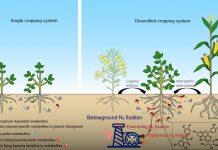Liu M, Liu J, Chen XF, Jiang CY, Wu M, Li ZP. Shifts in bacterial and fungal diversity in a paddy soil faced with phosphorus surplus. Biology and Fertility of Soils, doi: 10.1007/s00374-017-1258-1
Abstract
Abundant phosphorus (P) has been applied to paddy fields in the red soil region of subtropical China. Microbial communities play important roles in soil nutrient cycling; however, the effects of P surplus on soil microbial diversity and community composition are still unclear. Soils collected from paddy fields in subtropical China was incubated and subjected to four P treatments: 33 kg ha−1 (CK), 66 kg ha−1 (P1), 132 kg ha−1 (P2), and 264 kg ha−1 (P3). Changes in bacterial and fungal diversity and community composition were evaluated by high-throughput sequencing. The different P rates had no significant effect on bacterial diversity, whereas fungal richness and diversity indexes declined significantly by increasing P rates. Principle coordinate analysis (PCoA) also indicated a shift in fungal community composition when P rates were higher than 132 kg ha−1. Available P (AP) was the dominant factor affecting fungal community composition as evaluated by canonical correspondence analysis (CCA). Multivariate regression trees (MRT) revealed that the key threshold of 53.6 mg kg−1 of AP divided treatments into two distinct groups. Linear discriminant analysis effect size (LEfSe) showed that abundances of Pseudogymnoascus and Geomyces increased, but those of Penicillium and an unknown genus of Trichocomaceae decreased when AP was ≥ 53.6 mg kg−1.








